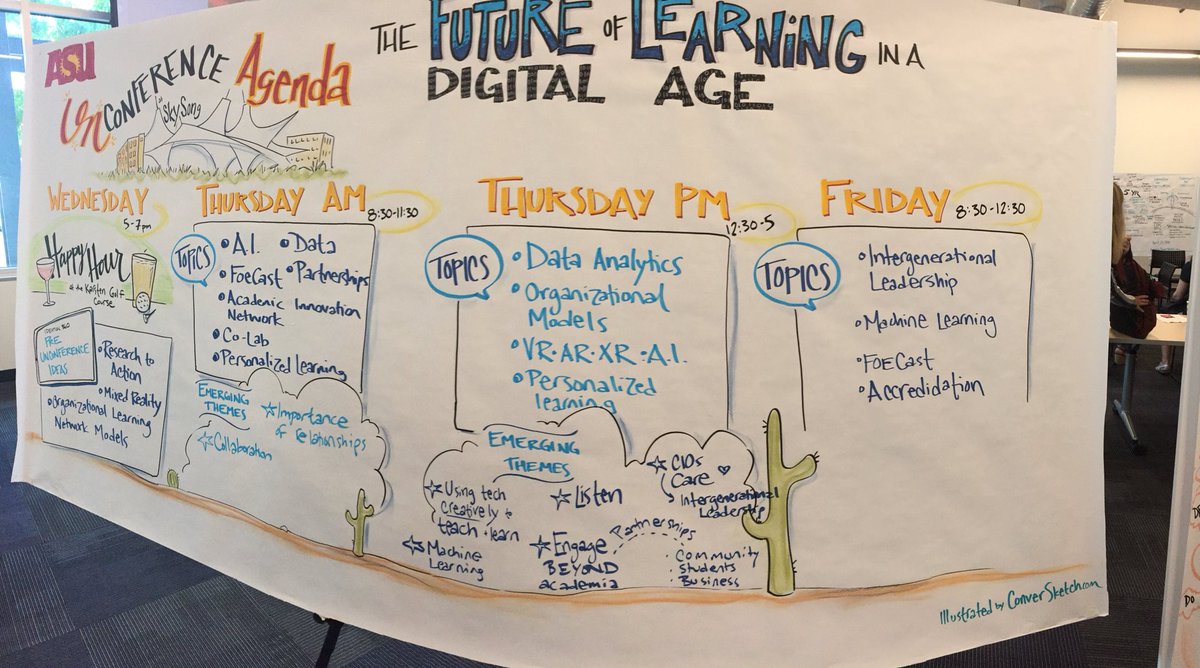You have /5 articles left.
Sign up for a free account or log in.
We may be at an academic conference inflection point.
Higher education gatherings seem to be evolving away from conferencing and towards unconferencing.
We may get to the point where we drop the “un” in “unconference”, much like we’ve dropped the digital from digital from photography. (Come to think of it, we should probably drop the “digital” from digital learning as well - it is all just learning).
Last week I attended an ASU unconference on the future of learning in the digital age. The best place to catch up with what was discussed at the event is probably by scrolling through #shapingedu.
Academic unconferences differ from traditional professional meetings in at least 3 ways.
First, they are usually small. There were 129 people at the event, with representatives from the of academic technology, online learning, media, consulting, instructional design, library, futurists, faculty, and edtech company tribes.
Second, they are often held on campuses - as opposed to at hotels or conference / convention venues. The location at ASU’s EdPlus offices was amazing, largely because anyone interested in the future of higher education needs to spend time with the people at EdPlus.
Third, and most importantly, the participants of an unconference largely create the agenda as the gathering unfolds. The event featured a few talks, but mostly the host and convener of the event Lev Gonick (ASU’s CIO) energetically funneled the time into conversations (or neighborhoods) around specific topics. Check out the illustration below by the truly incredible graphic facilitator Karina Mullen Branson for an idea of the big themes.
At this unconference I did two things that I’ve never done at any academic conferences or professional convening.
The first thing is something that I didn’t do. I didn’t speak.
I’m not saying that I not only did not give a talk or a presentation (which I didn’t), I also did not speak in any of the larger group conversations. The rule that I set for myself at this meeting was that if the number of people in a discussion was big enough that one needed a microphone to be hear, then I would not take the microphone.
Not contributing with my voice was something that I’ve never done. Usually I talk too much.
Making the decision to listen and never talk felt strange. Not contributing to larger conversations during an unconference goes against the grain of the culture of these convenings. If everybody made the same choice that I made to be quiet then the unconference would not have worked.
The second thing that I did differently was to actively make the choice to be in mostly small conversations. Rather than joining the big discussions taking place in the neighborhoods throughout the unconference, I grabbed 2 or 3 colleagues for smaller conversations.
Sometimes we had these discussions while walking around the ASU campus. Sometimes we talked on the couches in the lobby of SkySong.
The freedom to hack your own experience to optimize the value of the convening is one of the attributes that I appreciate most about an unconference. The unconference allows both individuals at the event, and the collective that comes together, to chart their own course.
Increasingly, I hear that academics want something different in their professional meetings and academic conferences. The unconference may not be the only model to follow, but I predict that more traditional conferences will take on attributes of the philosophy of unconferencing.
How has your approach to attending conferences (and unconferences) evolved?
Have you made active decisions to be more quiet in your own professional life?
What size groups do you feel are most productive in having conversations about your academic work?
Do you think that we are at an inflection point in how academics gather?

Photo by Angela Gunder, and illustration by Karina Mullen Branson, conversketch.com.








